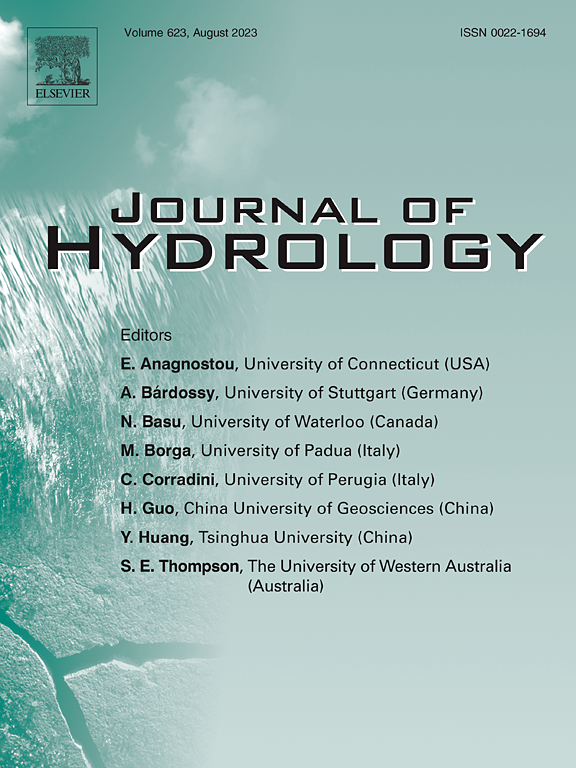Deep learning reveals future streamflow characteristics change and climate sensitivity
IF 5.9
1区 地球科学
Q1 ENGINEERING, CIVIL
引用次数: 0
Abstract
This study deploys the potential of Deep Learning (DL) technique for an improved future streamflow projection from General Circulation Model (GCM) simulations, by developing a reliable association between the observed streamflow and a set of primary meteorological variables at monthly scale over a historical period. Towards this, a DL-based Long Short-Term Memory (LSTM) framework is developed to capture the hidden complex dynamics between streamflow and its two primary hydrometeorological precursors – precipitation and temperature, identified through Kendall’s partial correlation analysis. After ensuring model stability through various combinations of hypothesized climatic forcings, the developed model is used for long-term projection of basin-scale streamflow characteristics, utilizing future-projected bias-corrected temperature and precipitation data from six state-of-the-art GCMs following two emission scenarios. In general, the proposed DL-based approach is found to outperform two benchmark machine learning models in identifying the basin-specific climate sensitivity controlling streamflow variation. The efficacy of the proposed model is demonstrated over four rain-fed tropical river basins in India, located in different climate zones, namely Bhadra, Netravati, Tenughat, and Upper Narmada river basins. All four diverse basins showcase more than 90% correlation, with Netravati basin achieving an impressive 0.98 correlation coefficient over the testing period. Likewise, the Nash–Sutcliffe model efficiency values, evaluated over the testing period, range from 0.83 to 0.95 across these basins affirming the model’s robust and efficient performance. This multi-model, multi-scenario analysis reveals an increased streamflow variability in all the basins under a wetter and hotter climate in future, which gets more pronounced with time and higher emission scenario. The flow is projected to increase in the monsoon months, along with a practically unchanged or marginally less flow over the dry months. Such redistribution of streamflow pattern in near future definitely requires suitable management strategies and their implementation in well advance.
深度学习揭示了未来的水流特征、变化和气候敏感性
本研究利用深度学习(DL)技术的潜力,通过在一个历史时期的月尺度上建立观测到的河流流量和一组主要气象变量之间的可靠关联,改进了一般环流模式(GCM)模拟的未来河流预测。为此,开发了基于dl的长短期记忆(LSTM)框架,通过Kendall的部分相关分析确定了流量及其两个主要水文气象前兆-降水和温度之间隐藏的复杂动态。在通过各种假设的气候强迫组合确保模式的稳定性之后,开发的模式用于长期预测流域尺度的水流特征,利用来自六个最先进的gcm的未来预估偏差校正的温度和降水数据,在两个排放情景下。总体而言,本文提出的基于dl的方法在识别控制流量变化的流域特定气候敏感性方面优于两种基准机器学习模型。该模型的有效性在印度位于不同气候带的四个雨养热带河流流域得到了验证,即Bhadra、Netravati、Tenughat和Upper Narmada河流域。所有四个不同的盆地都显示出超过90%的相关性,其中Netravati盆地在测试期间的相关系数达到了令人印象深刻的0.98。同样,在测试期间,Nash-Sutcliffe模型的效率值在0.83到0.95之间,证实了该模型的稳健和高效性能。多模式、多情景分析表明,未来气候变暖变湿条件下,各流域的流量变率将增加,且随时间和排放情景的增加而增加。预计季风月份的流量将增加,而干旱月份的流量几乎不变或略有减少。在不久的将来,这种流型的再分配必然需要适当的管理策略和提前实施。
本文章由计算机程序翻译,如有差异,请以英文原文为准。
求助全文
约1分钟内获得全文
求助全文
来源期刊

Journal of Hydrology
地学-地球科学综合
CiteScore
11.00
自引率
12.50%
发文量
1309
审稿时长
7.5 months
期刊介绍:
The Journal of Hydrology publishes original research papers and comprehensive reviews in all the subfields of the hydrological sciences including water based management and policy issues that impact on economics and society. These comprise, but are not limited to the physical, chemical, biogeochemical, stochastic and systems aspects of surface and groundwater hydrology, hydrometeorology and hydrogeology. Relevant topics incorporating the insights and methodologies of disciplines such as climatology, water resource systems, hydraulics, agrohydrology, geomorphology, soil science, instrumentation and remote sensing, civil and environmental engineering are included. Social science perspectives on hydrological problems such as resource and ecological economics, environmental sociology, psychology and behavioural science, management and policy analysis are also invited. Multi-and interdisciplinary analyses of hydrological problems are within scope. The science published in the Journal of Hydrology is relevant to catchment scales rather than exclusively to a local scale or site.
 求助内容:
求助内容: 应助结果提醒方式:
应助结果提醒方式:


